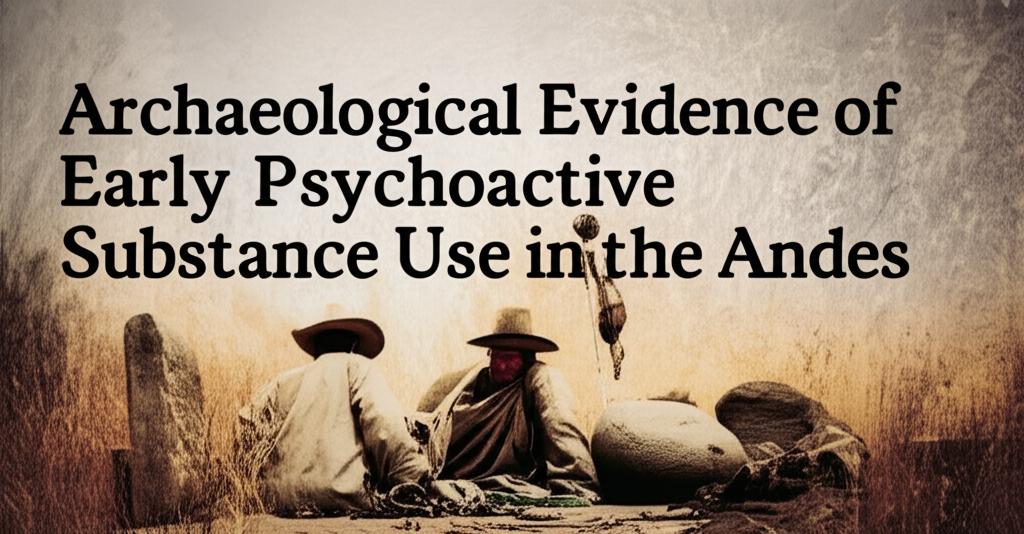Archaeological investigations in the Andean region of South America continue to reveal a long and complex history of psychoactive substance use, deeply intertwined with ritual practices and social structures. Recent discoveries, particularly at sites like Chavín de Huántar in Peru, are shedding new light on how these substances were utilized and controlled by ancient societies.
New Discoveries at Chavín de Huántar:Excavations at Chavín de Huántar, a significant ceremonial center that flourished between 1200 and 400 B.C., have unearthed the earliest direct evidence of psychoactive plant use in the Peruvian Andes. A team of archaeologists, including researchers from the University of Florida and Stanford University, discovered bone snuff tubes within monumental stone structures. Chemical and microscopic analysis of these artifacts revealed traces of nicotine from wild tobacco relatives and residue from vilca beans, a known hallucinogen containing DMT-related compounds. These findings were published in the Proceedings of the National Academy of Sciences in May 2025.
The context of these discoveries is particularly revealing. The snuff tubes were found in small, private chambers, suggesting that access to these psychoactive substances and the rituals involving them was not widespread. Researchers believe these rituals were tightly controlled and likely reserved for a select elite. This restricted access to altered states of consciousness may have played a crucial role in establishing and reinforcing social hierarchies. By enveloping users in an aura of the supernatural, Chavín leaders could have convinced the populace of their connection to mystical powers, thereby legitimizing their authority and the existing social order.
The Chavín culture, a predecessor to the Inca Empire, is known for its sophisticated art and monumental architecture. These new findings add another layer to our understanding of their religious and social practices, indicating that the manipulation of sensory experiences, including the use of hallucinogens, was a deliberate strategy. Some scholars suggest that these practices, along with other sensory manipulation techniques like disorienting soundscapes and restricted light, were integral to shaping the religious and social dynamics of Chavín society. Evidence from Chavín art, which includes representations of plants and humans in altered states, has long hinted at the use of psychoactive substances, and these new findings provide direct material confirmation. The research indicates the likely consumption of mixed vilca and Nicotiana powders, representing the oldest evidence for the inhalation of such a mixture in the Americas.
Broader Context of Psychoactive Use in the Andes:The use of psychoactive substances was not limited to the Chavín culture. Archaeological evidence points to a long history of such practices across the Andes:
- Coca Leaves: The use of coca leaves (the source of cocaine) dates back thousands of years in the Andean region. Archaeological evidence from coastal Ecuador suggests use as far back as 5,000 years ago, while traces have been found in mummies in northern Chile dating back 3,000 years. Coca was integral to daily life, religious rituals, and traditional medicine, used to combat fatigue, hunger, and altitude sickness. By the time of the Inca Empire, coca use was widespread, though its cultivation and distribution became more centrally controlled. Recently found leaves in the Ayacucho Valley provide the first direct evidence of coca use in the Peruvian central highlands, dating to between the end of the Early Intermediate Period (ca. 1–550 A.D.) and the beginning of the Middle Horizon Period (ca. 550–1100 A.D.).
- Vilca (Anadenanthera colubrina var. cebil): Vilca, a potent hallucinogen, has a long history of ritual use. The earliest archaeological evidence for vilca use in South America comes from Inca Cueva in northern Argentina, dating back 4,000 years. It was often snuffed or smoked. Remains of vilca seeds, along with paraphernalia like snuff trays and tubes, have been found in various pre-Hispanic archaeological sites in northwestern Argentina and northern Chile.
- Other Substances and Practices: Research in Bolivia has uncovered a 1,000-year-old leather bag containing traces of multiple psychoactive compounds, including cocaine, bufotenin (found in vilca and other sources), psilocin (suggesting possible psychedelic mushroom use), harmine, and dimethyltryptamine (DMT) – the latter two being components of ayahuasca. This discovery is significant as it represents the largest number of psychoactive substances found in a single archaeological assemblage from South America and suggests the possibility of combining different plants for varied effects or to extend hallucinations. The Wari civilization (flourishing from about 500 to 1000 C.E.) in the Peruvian Andes is believed to have added vilca to a beer-like chicha, possibly as a way to maintain social cohesion and forge bonds with other communities, a departure from the more exclusive use seen in some other cultures.
The ongoing research highlights that the use of psychoactive substances in ancient Andean societies was not merely for individual spiritual journeys or shamanic healing. Instead, it was often deeply integrated into institutionalized rituals and played a significant role in the development and maintenance of social and political hierarchies. The controlled access to these powerful substances and the mystical experiences they induced appears to have been a key tool for elites to assert and legitimize their authority. These findings underscore the complex interplay between religion, power, and psychoactive plant use in shaping early Andean civilizations.

